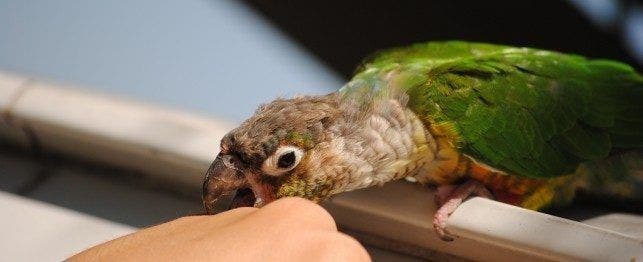
How to Stop Your Bird from Biting
Biting is annoying and can even be dangerous, but since birds are prey species, punishing them can be damaging – both physically and emotionally.
The best response to a bird nipping painlessly on your flesh is no response at all. Some birds perceive almost any response as reinforcement for their behavior. After all, behavior that isn’t reinforced isn’t likely to become a habit.
What if it’s more than a “nip”? If your bird bites your hand, move it toward him, and he’ll have to let go as your hand approaches his body. If your bird bites another part of you, remove him immediately, using a towel if necessary.
Preventing Biting
Good care fosters good behavior. Make sure your bird has the right size and type of cage, proper cage placement, sufficient exercise, adequate sleep, clean water for drinking and bathing, good food and ample opportunities for interaction.
Practice Patterning Routines
Pet birds can be taught good behavior and cooperation through redundant, happy, patterning routines. The most commonly discussed patterning routine for parrots is “step-ups,” which involves a human prompt for the bird to step onto a hand or perch. The bird learns what’s expected by practicing stepping from hand-to-hand, and from hand-held-perch to hand, or perch-on-command.
Practice in safe, neutral territory and be sure that your hand is approaching from below, toward your bird’s belly rather than from the front. With regular practice, a strong verbal command to “step-up” is then always greeted with a little lifted foot. Actually, once your bird learns to associate happy interaction with the words “step-up,” he’ll probably begin using those words when he wants to be picked up.
Companion parrots must also learn to enjoy, appreciate, or at least tolerate towels. They learn this by playing games such as “peek-a-boo” from behind a towel or “find-the-toy.” The more you play, the more easily you’ll be able to stimulate these interactions later. All this cooperation patterning when your bird is one, two, three, or five years old, is intended to prevent the development of uncooperative or violent behavior later, when he reaches sexual maturity.
Distracting to Prevent Biting
If a previously well-patterned bird is learning to bite, you want to re-pattern the bird to cooperative behavior. It’s easier to stimulate successful distractions if you can see a bite coming and respond before the bird takes a nip. Practicing step-ups or other enjoyable routines in unfamiliar territory can help your bird shift gears. The following are other distraction games you can “play” with your bird:
The Wobble
This device should only be used occasionally. If it’s being used frequently, then it isn’t working and should be discontinued. It’s best employed just before the nip, but may also be used just as the nip occurs. It doesn’t work at all if you try to use it after the nip.
When your nipping bird is sitting on a hand or hand-held perch, gently wobble or slightly turn your hand so your bird has to pay attention in order to regain his balance. Maintain eye contact and remind your bird either to “Be a good bird” or to “Be careful.” Be sure that your hand is being offered properly – coming from below and just over the feet near the place where the leg joins the belly – when prompting for a step-up. This must be done carefully with a shy bird so he doesn’t fall or get scared.
Good Hand/Bad Hand
The most common time for a nip or bite is when your bird is being removed from a familiar perch or from his cage. Here’s how to put a stop to that.
Maintain eye contact and offer your hand to be stepped on, being careful to always approach from below your bird. Just as your prompt hand begins its approach to your bird, present an unfamiliar object just out of reach of the bird’s beak (with one hand) and give the “step up” command (with the other hand) followed by “Be a good (or pretty) bird.”
Eye contact is especially important here. Your bird will often maintain eye contact rather than bite. If an introduced object distracts your bird, he’ll seek to regain eye contact rather than take the time to bite after being distracted. Even if your bird bites, the unfamiliar object will probably receive the bite. Note, however, that the distraction object must be nontoxic and big enough to be effective – yet not so big that it frightens the bird.